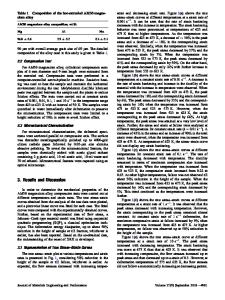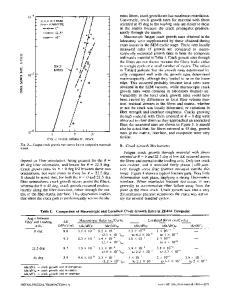Low-Cycle Fatigue Behavior of an As-Extruded AM50 Magnesium Alloy
- PDF / 627,727 Bytes
- 7 Pages / 594 x 792 pts Page_size
- 46 Downloads / 326 Views
Low-Cycle Fatigue Behavior of an As-Extruded AM50 Magnesium Alloy LIJIA CHEN, CHUNYAN WANG, WEI WU, ZHENG LIU, GRIGORETA M. STOICA, LIANG WU, and PETER K. LIAW The low-cycle fatigue behavior of an as-extruded AM50 magnesium alloy has been investigated. The cyclic stress response of the alloy strongly depends on the imposed strain amplitude. It is also noted that at the higher total strain amplitudes, the alloy exhibits a pronounced anisotropic deformation behavior in the direction of tension and compression, where the width of the s-e hysteresis loop in the compressive direction is greater than that in the tensile direction. At the total strain amplitude of 1.5 pct, a serrated flow can be observed in both tensile and compressive directions of the s-e hysteresis loop. This means that dynamic strain aging takes place during fatigue deformation. The relation between elastic and plastic strain amplitudes with reversals to failure shows a monotonic linear behavior and can be well described by the Basquin and Coffin–Manson equations, respectively. In addition, crack initiation and propagation modes are suggested, based on scanning electron microscopy observations on the fracture surfaces of fatigued specimens. I. INTRODUCTION
MAGNESIUM alloys, which have low density as well as high specific strength and stiffness, are considered as the lightest metal materials among practically used engineering structural materials. Recently, much attention has been paid to magnesium alloys for reducing the weight of a vehicle.[1,2,3] For applications to load-bearing components in the automotive industry, it is necessary to evaluate various fatigue properties. Magnesium alloys are usually classified into two categories: casting and wrought alloys. In casting magnesium alloys, defects such as casting porosity and inclusion, which commonly act as crack sources, are harmful for fatigue properties, and may facilitate fatigue crack initiation, reduce lifetimes, and decrease cyclic strength.[4–9] On the contrary, wrought magnesium alloys are basically defectfree and thus exhibit better fatigue properties than casting alloys.[9–12] In addition, the evaluation on fatigue behavior of wrought alloys is of great interest to understand the intrinsic fatigue mechanism of magnesium alloys. Although previous work concerning the fatigue behavior of magnesium alloys mainly focused on their high-cycle fatigue properties, a few studies on low-cycle fatigue behavior have been reported. Eisenmeier and co-workers[13] investigated the low-cycle fatigue behavior of the die-casting Mg-9Al-1Zn (AZ91) alloy at room temperature and at 130 °C. They found that the fatigue life data at both temperatures could be described well by the laws of Manson– LIJIA CHEN and ZHENG LIU, Professors, CHUNYAN WANG, Instructor, and WEI WU, Graduate Student, are with the School of Materials Science and Engineering, Shenyang University of Technology, Shenyang 110023, People’s Republic of China. Contact e-mail: [email protected] GRIGORETA M. STOICA and LIANG WU, Graduate Students, and PET
Data Loading...











